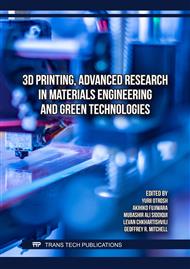[1]
A.A. Al-allaq, J.S. Kashan, A review: In vivo studies of bioceramics as bone substitute materials, Nano Select 4(2) (2023) 123-144.
DOI: 10.1002/nano.202200222
Google Scholar
[2]
S. Kalsi, J. Singh, S.S. Sehgal, N.K. Sharma, Biomaterials for tissue engineered bone Scaffolds: A review, Materials Today: Proceedings 81 (2023) 888-893.
DOI: 10.1016/j.matpr.2021.04.273
Google Scholar
[3]
A. Szwed-Georgiou, P. Płociński, B. Kupikowska-Stobba, M.M. Urbaniak, P. Rusek-Wala, K. Szustakiewicz, P. Piszko, A. Krupa, M. Biernat, M. Gazińska, M. Kasprzak, K. Nawrotek, N.P. Mira, K. Rudnicka, Bioactive Materials for Bone Regeneration: Biomolecules and Delivery Systems, ACS Biomaterials Science & Engineering 9(9) (2023) 5222-5254.
DOI: 10.1021/acsbiomaterials.3c00609
Google Scholar
[4]
H. Budharaju, S. Suresh, M.P. Sekar, B. De Vega, S. Sethuraman, D. Sundaramurthi, D.M. Kalaskar, Ceramic materials for 3D printing of biomimetic bone scaffolds – Current state-of-the-art & future perspectives, Materials & Design 231 (2023) 112064.
DOI: 10.1016/j.matdes.2023.112064
Google Scholar
[5]
M.S. Shoushtari, D. Hoey, D.R.A. Biak, N. Abdullah, S. Kamarudin, H.S. Zainuddin, Sol–gel‑templated bioactive glass scaffold: a review, Research on Biomedical Engineering 40(1) (2024) 281-296.
DOI: 10.1007/s42600-024-00342-x
Google Scholar
[6]
P. Naruphontjirakul, P. Panpisut, S. Patntirapong, Zinc and strontium-substituted bioactive glass nanoparticle/alginate composites scaffold for bone regeneration, International Journal of Molecular Sciences 24(7) (2023) 6150.
DOI: 10.3390/ijms24076150
Google Scholar
[7]
A. Haider, A. Waseem, N. Karpukhina, S. Mohsin, Strontium-and zinc-containing bioactive glass and alginates scaffolds, Bioengineering 7(1) (2020) 10.
DOI: 10.3390/bioengineering7010010
Google Scholar
[8]
P. Naruphontjirakul, P. Kanchanadumkerng, P. Ruenraroengsak, Multifunctional Zn and Ag co-doped bioactive glass nanoparticles for bone therapeutic and regeneration, Scientific Reports 13(1) (2023) 6775.
DOI: 10.1038/s41598-023-34042-w
Google Scholar
[9]
T.-Y. Yang, G.-I. Chern, W.-H. Wang, C.-J. Shih, Synthesis, Characterization, and Bioactivity of Mesoporous Bioactive Glass Codoped with Zinc and Silver, International Journal of Molecular Sciences 24(18) (2023) 13679.
DOI: 10.3390/ijms241813679
Google Scholar
[10]
Z. Azari, F. Kermani, S. Mollazadeh, F. Alipour, A. Sadeghi-Avalshahr, M. Ranjbar-Mohammadi, B.J. Kondori, Z. Mollaei, S.A. Hosseini, S. Nazarnezhad, Fabrication and characterization of cobalt-and copper-doped mesoporous borate bioactive glasses for potential applications in tissue engineering, Ceramics International 49(23) (2023) 38773-38788.
DOI: 10.1016/j.ceramint.2023.09.214
Google Scholar
[11]
N. Alasvand, S. Simorgh, M.M. Kebria, A. Bozorgi, S. Moradi, V.H. Sarmadi, K. Ebrahimzadeh, N. Amini, F. Kermani, S. Kargozar, Copper/cobalt doped strontium-bioactive glasses for bone tissue engineering applications, Open Ceramics 14 (2023) 100358.
DOI: 10.1016/j.oceram.2023.100358
Google Scholar
[12]
S.R. Gavinho, A.S. Pádua, L.I.V. Holz, I. Sá-Nogueira, J.C. Silva, J.P. Borges, M.A. Valente, M.P.F. Graça, Bioactive glasses containing strontium or magnesium ions to enhance the biological response in bone regeneration, Nanomaterials 13(19) (2023) 2717.
DOI: 10.3390/nano13192717
Google Scholar
[13]
K. Deshmukh, T. Kovářík, T. Křenek, D. Docheva, T. Stich, J. Pola, Recent advances and future perspectives of sol–gel derived porous bioactive glasses: a review, RSC advances 10(56) (2020) 33782-33835.
DOI: 10.1039/d0ra04287k
Google Scholar
[14]
D. Dhinasekaran, A. Kumar, Fabrication of Bioactive Structures from Sol–Gel Derived Bioactive Glass, Bioactive Glasses and Glass‐Ceramics: Fundamentals and Applications (2022) 87-117.
DOI: 10.1002/9781119724193.ch6
Google Scholar
[15]
F. Baino, E. Fiume, M. Miola, E. Verné, Bioactive sol‐gel glasses: processing, properties, and applications, International Journal of Applied Ceramic Technology 15(4) (2018) 841-860.
DOI: 10.1111/ijac.12873
Google Scholar
[16]
F. Baino, S. Fiorilli, C. Vitale-Brovarone, Bioactive glass-based materials with hierarchical porosity for medical applications: Review of recent advances, Acta biomaterialia 42 (2016) 18-32.
DOI: 10.1016/j.actbio.2016.06.033
Google Scholar
[17]
C. Wang, J. Wang, Q. Li, S. Xu, J. Yang, A review on recent development of foam Ceramics prepared by particle-stabilized foaming technique, Advances in Colloid and Interface Science (2024) 103198.
DOI: 10.1016/j.cis.2024.103198
Google Scholar
[18]
J.R. Jones, Reprint of: Review of bioactive glass: From Hench to hybrids, Acta biomaterialia 23 (2015) S53-S82.
DOI: 10.1016/j.actbio.2015.07.019
Google Scholar
[19]
A.E. Danks, S.R. Hall, Z. Schnepp, The evolution of 'sol–gel' chemistry as a technique for materials synthesis, Materials Horizons 3(2) (2016) 91-112.
DOI: 10.1039/c5mh00260e
Google Scholar
[20]
T. Kokubo, H. Takadama, How useful is SBF in predicting in vivo bone bioactivity?, Biomaterials 27(15) (2006) 2907-15.
DOI: 10.1016/j.biomaterials.2006.01.017
Google Scholar
[21]
C. Gögele, S. Wiltzsch, A. Lenhart, A. Civilleri, T.M. Weiger, K. Schäfer-Eckart, B. Minnich, L. Forchheimer, M. Hornfeck, G. Schulze-Tanzil, Highly porous novel chondro-instructive bioactive glass scaffolds tailored for cartilage tissue engineering, Materials Science and Engineering: C 130 (2021) 112421.
DOI: 10.1016/j.msec.2021.112421
Google Scholar
[22]
C.H. Kong, C. Steffi, Z. Shi, W. Wang, Development of mesoporous bioactive glass nanoparticles and its use in bone tissue engineering, Journal of Biomedical Materials Research Part B: Applied Biomaterials 106(8) (2018) 2878-2887.
DOI: 10.1002/jbm.b.34143
Google Scholar


